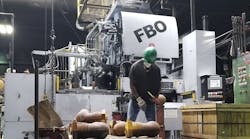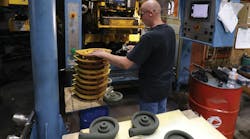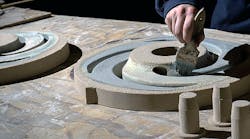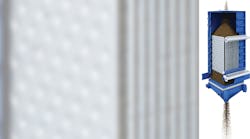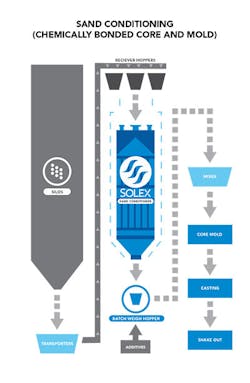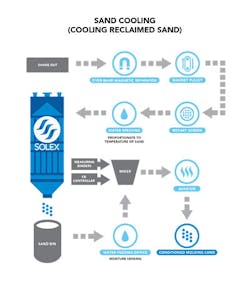In the Midwest, seasonal temperature swings cause 70°F (21°C) changes to core sand temperature. Temperature variations in core and molding sand causes inefficiencies to the coremaking process, reduces core quality, and increases rework. Foundries looking for a technological solution to sand temperature variations should consider an innovation by Solex Thermal Sciences, which has decades of experience in bulk solids handling and heat transfer for the fertilizers, oilseeds, proppant, salt, and sugar processing industries.
Foundries that have documented core sand-temperature variations up to 20°F have applied the Solex technology and expertise to the problem, and are able to maintain a desired temperature to within +/-1° — even when ambient temperatures fluctuate.
The Solex design keeps the working fluid separate from the sand. It consumes less energy in operation because it is a gravity-fed, vertical-column heat exchanger with material flowing uniformly through a bank of hollow steel plates. Heated or cooled water or glycol is the heat transfer fluid flowing through the internal passages of the hollow steel plates and indirectly controls the sand temperature by conduction. The plates are fully welded, ensuring the heat transfer fluid (HTF) is kept separate from the sand.
As with conventional liquid or gas exchangers, the HTF and product flows are counter-current to gain greater thermal efficiency. Below the Solex plate bank is a mass-flow vibratory feeder ensuring uniform velocity and residence time through the heat exchanger, as well as delivering precise rate or batch control. Figure 1 shows the indirect plate heat-exchanger design.
Challenges in metalcasting — Consistent control of sand temperatures in core- and moldmaking is a challenge. The problem is magnified when process disruptions result in cooling or over heating of sand. Accurate temperature control is vital to binder mixing and process efficiency. Not having this control can result in productivity loss, core mold scrap, scrapped castings, and rework.
Precise sand temperature control is vital to binder optimization. Lack of accurate sand temperature control results in excessive use of expensive binders to compensate. This is a costly and inefficient way to deal with sand control issues in the coremaking and molding step of the process.
The current use of fluid-bed technology for sand temperature control introduces direct contact between the air-heat transfer fluid and the sand product. This highly energetic, blowing air results in silica dusting that contributes to the personnel exposure of respirable crystalline silica. New application of indirect heat-exchange technology that reduces workers’ risk of silicosis is advantageous, and will contribute to a safer and healthier work environment in foundries.
Figure 2. Example of sand cooling process design
Applying Solex technology — In advance of core- and moldmaking, sand is blended with a small amount of expensive ingredients, including chemical binders and catalyst, in a high-speed mixer. The ingredients begin a chemical-reaction hardening process when discharged from the mixer to the sand hopper.
In this process it’s important to maintain consistent temperature of the sand before it is blended with the ingredients. If the sand is too hot or too cold the amount of ingredients must be adjusted, which can create inconsistencies in casting quality as well as waste expensive raw materials.
An added advantage of the indirect plate heat exchanger design is that it will maintain consistent sand temperature even when the casting process is interrupted or shut down. Some foundries could shut down over the weekend: With the Solex system a temperature-control module (TCM) can maintain the sand temperature during the shutdown period, and the process can restart without delay or casting quality issues caused by inconsistent sand temperatures.
In green sand casting, it is critical to maintain consistent grain fineness (per the American Foundry Society Grain Fineness Number, or AFS-GFN) to ensure a reliable and efficient process. Fluidizing heaters can alter the AFS GFN before the sand reaches the molding stage. Also, great care needs to be taken when designing sand handling equipment to prevent and eliminate sand segregation. Indirect plate heat-exchange technology offers this advantage because there is neither abrasion nor segregation occurring within the equipment.
Sand is an abrasive product, so there is always concern of wear to process equipment. The Solex indirect plate heat-exchange equipment is designed to form a pile of material above the leading edge of the plates. This ensures no impingement between the product and the plates. Then, the bed of sand can flow slowly past the plates, minimizing the chance for wear.
In addition, for processes that undergo several fill/empty cycles per day, plate caps can be used to protect the plate leading edges.
Figure 3. Example of sand conditioning process design
Maintenance requirements are almost zero for this system: there are no moving parts and low energy input, and thus no wear parts to replace. The HTF cooling water is enclosed by the plates and kept fully separate from the ambient air and core production sand product. This will virtually eliminate any build-up of material that could interfere with efficient and reliable operation. Water contamination and downstream drain and pipe blockages are eliminated, too.
The system maintains the highest obtainable efficiency using water indirectly as the heat transfer medium. Fluidized beds require blowers, ducting, and cleaning equipment.
The Solex heat exchanger has a compact design and footprint that offers easy access to heat-exchange plates, with no moving parts or pinch points, for safety.
Figure 3 shows an example of the positioning of the Solex heat exchanger in the cooling of reclaimed sand process.
Other metalcasting challenges — Introducing innovative technologies from other industries can help metalcasters to address some of their particular business challenges. Foundries working in partnership with Solex have significantly improved their ability to maintain precise grain-to-grain sand temperature, and this helps them realize benefits through the optimization of binder usage, reduced scrap cores and rework of castings and reduced silica dusting in the workplace.



